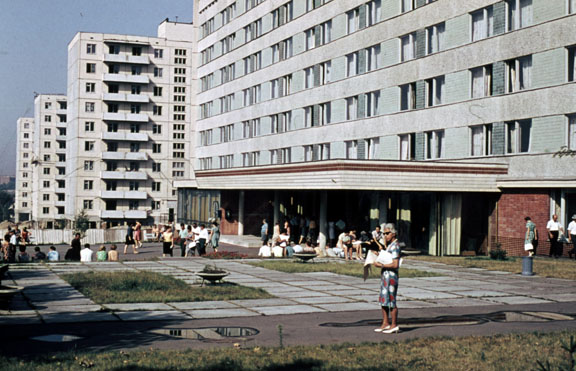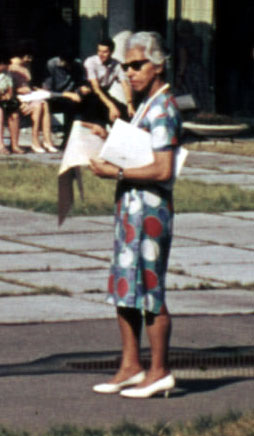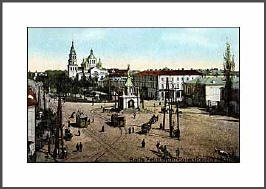
Interpreting old family photos as a source of genealogical information
The following is loosely based on the transcript of an interview on the Northern Virginia cable TV in May, 2003 and on the preparatory notes to the program.
Arlene Sachs: Boris, the subject is unusual and somewhat intriguing. I know that you’ve been collecting old photos for many years, even before you started doing genealogy, before you started FAST Genealogy Service. It is true, that many families did not bother to save family documents that we, genealogists, consider precious. We are often left with scattered pieces of information that are really pieces of a puzzle, or many puzzles, like shoe boxes of unsigned photographs. What can you read in them?
BF: Unfortunately, not many old photographs are accompanied with detailed captions on who was pictured, where, when and how was related to everyone else in the photo. Pictures are worth thousand words, but rather than reading them we often have to create them. "Reading" old photographs is more about interpreting the information, building conjectures, it is intelligent guessing if you will. As I see it, one’s success in analyzing photographs, much like his success in genealogy research in general depends largely on his reasons for doing it, and on the expectations. If all you want is to build a family tree filed with names and dates, you may find too many stumbling block on your way and give up too soon. If you are willing to learn about your ancestors in the larger context of their times and societies, the reward will be far greater. And the chance is the tree will grow faster.
I started taking pictures when I was 11 or 12. Ten years later I was collecting old pre-1917 views of old Russian towns. I could not even explain initially what attracted me in these old photos. It was much later that I realized it was a desire to glimpse at life before the Bolsheviks took over. As time went by, I understood that everything I was learning about old Russia was about Russian Jews too. This old photo of Cathedral Square in Zhitomir, Ukraine, contains nothing Jewish, at the first glance. People, a street car, a cathedral, another church is seen far away... But look at the business directory from the same time period, and you will find out that there were at least two dozen small businesses right around the square that were owned and operated by the Jews.
With regards to personal photos (as oppose to city views) and genealogy, I sensed that photographs can tell us - occasionally - what is missing in documents. I felt they can be more than illustrations, they can stimulate new research and findings.
The photo on the left is of younger and somewhat handsome Boris, taken in 1988. Two or three years later we met with newfound American relatives. In the course of a conversation, they pulled out a proverbial shoe box of old family photos, - and we all were amazed by obvious similarities between me and this man of the early 1900's whom nobody could identify.
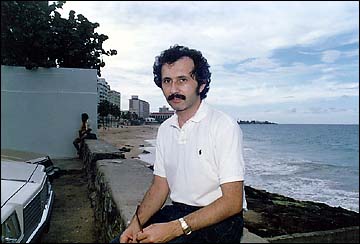
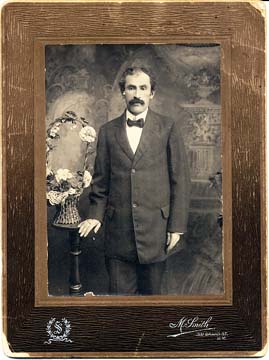
I still do not know who he is, but one day - I hope - I will find his place on my family tree. In practical terms, genealogically speaking, I learned of an ancestor, removed from me by at least three generations and sideways. I know that he emigrated from Russia to America. It’s a beginning
Since I collect old photographs, identifying people and places is almost automatic to me. Even simply staring at photos for a long time, can be an interesting exercise in photo-interpretation. And, in some cases it can really help one’s genealogical research, even if it does not provide factual information or definitive answers. I try to look beyond first impressions and feelings. To mine old photos is a real challenge to the mind.
The next two photos came from the same family pictures lot of my relatives. None of the people are identified and are still unknown to me.
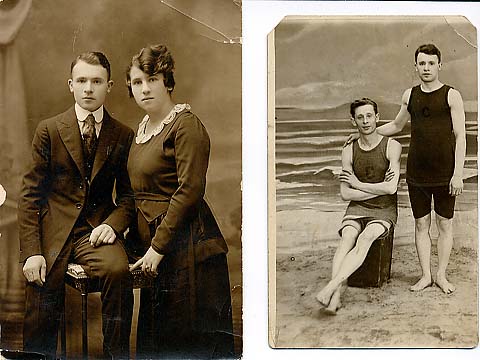
Look at the left photo. Are they brother and sister or a husband and a wife? Their faces are tense as they listen to photographers’ directions, that was my immediate impression. Now look at their postures. Regardless of who they were to each other, you know who was a domineering figure in this relationship, who was the boss. The woman might have been an older sister who was the mother figure, but I think she was a somewhat domineering wife. You can also see she was a bit older and more mature than the man... The fashions may provide a clue to the time period. So if one day I learn of a couple where the wife was older than the husband, I will revisit this photo.
Actually, we will revisit it in a few seconds, after studying the other couple. On the one hand, it looks like a studio setting because the ocean is painted. On the other hand, the sand looks real. Perhaps it was a studio on the beach, may be in Long Island, or in Atlantic City. Both men look very relaxed, especially the one who is sitting. They obviously enjoy each other’s company. While I do not know yet what the letter C on their undershirts means, I assume it is a logo of a sports team. If I learn one day that certain Sam Glizerman played sports, I will try to find what sports he played, and who were his team members.
Another conjecture that comes to mind when we compare the two photos is that the two young men most likely grew up in America, whether they were born here or in Russia, while the other couple more likely grew up in Russia. Even after living here for some time, they still could not make themselves relaxed enough, never mind the very formal studio setting.
February 23, 2022. Update.
I learned the names of the couple about two years ago. The man was an immigrant from Zhitomir, the woman was actually born in the USA. Their grandson, who I traced, shred with me a photo of the same couple some 40 years later. Unfortunately, he disagreed with me on the analysis of both photos and stopped commnicating.
Of course, I can be totally wrong in my assumptions regarding these photos, but it’s a beginning of an identification process.
There is an exercise anyone can take with virtually any photo. Look at the image for really long time, say 30 minutes, uninterrupted, and record your observations, from the first impression to the wild fantasies. Here is the case in point.
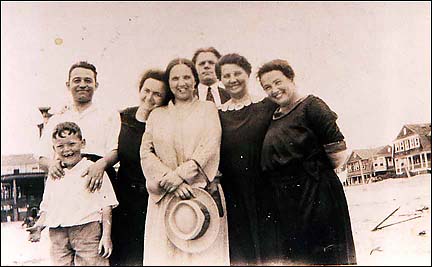
The very first reaction to this photo is that you want be a member of this group and to partake in their loving relationship and fun. The people are Jewish; most likely members of the same family; two women on the right are sisters; possibly four out of six people are siblings; the woman second from the right is married to the man on the background; you can sense he leans closer to her than to other women. The woman in the center holds the photographer’s hat. Perhaps, she is the oldest sister of them all, they all have very wide nose, almost Negro type. The time frame is probably 1920's-1930's; location is possibly US sea shore; the two houses on the right may provide a clue. So, if you have a family with several sisters - that may be it. Identifying who was who is another challenge, but here you have at least two clues: the boy can be a son of only one couple; and you may come across a note that one of the husbands was a photography fan... You can see his wife holding a straw hat.
Again, what I just observed can be dismissed as pure speculation with regards to blood or marital relationship. I just think that photographs can provide an incredible impetus to one’s research. I am not aware if the subject of photo-interpretation is taught anywhere, except, possibly in the context of military intelligence where the emphasis must be on identifying places, distances, and types of buildings and equipment. There is a book published some 30 years ago by a psychologist Robert Akeret. It is called Photoanalysis, although its emphasis is not on genealogy, but rather on interpreting the hidden psychological meaning of personal photographs. In fact, one of the chapters in the book is called Rediscovering the family album. Robert Akeret expands on the idea of looking at family photos over and over. In his opinion, every time we look at the same old images, we may discover new details, new meanings, new experiences.
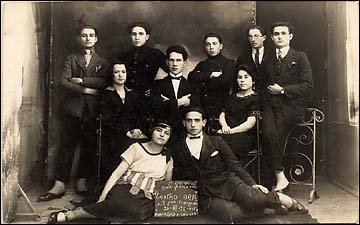
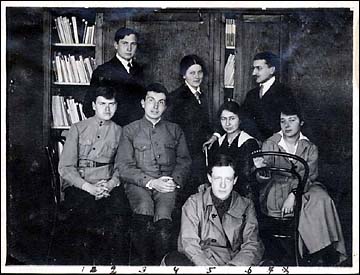
Over time, I have compiled a list of questions to consider when studying a photograph. It was initially based on Robert Akeret’s suggestions, but is constantly revised and expanded, as almost every new photograph brings up new questions.
- What is your immediate impression? Who and what do you see?
- What feelings does the photo evoke in you?
- What is obvious, and what is subtle?
- What, if anything, is happening in a photo?
- What is the photographer’s relation to the subjects? Is he a family member, a professional? Do people look relaxed or tense?
- Any significance of the background, real or symbolic?
- Can you identify the social and economic class of the people photographed? Their cultural background?
- What can you say about body language? Do people show them off, hide behind?
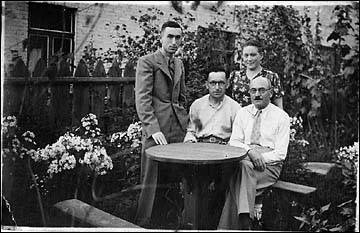
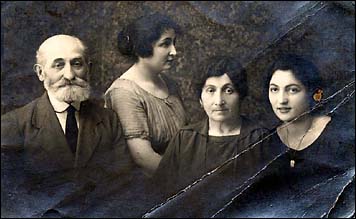
- What do you notice about the emotional state of each person? Is he attractive, depressed, shy, proud, fearful, suspicious, introspective, happy, anxious, bright, curious, distant, rigid, friendly, arrogant, lonely, trusting, crazy, strong, weak?
(It is useful to consider that in the early days of photography, because of the slow speed of emulsion, exposures often were long, sometimes a minute or longer. That is an obvious factor in interpreting how someone comes across on a photo. But even that was not always an impediment. Some people always show emotions more than others.)
- In a group photo - that is photo of more than one person - what do you notice about the mood? How do people relate to each other? What do you notice about physical intimacy or distance? Are the people touching physically? Do they lean against each other or keep distance? Are they tense or relaxed? What are their messages toward each other? Who is a dominant figure? Do you sense love, animosity, something in between?
- Analyze various parts of each person. Look at the posture, hands, arms, legs, the face, the eyes, the mouth. Do you sense harmony or inconsistencies?
- Is there anything that disturbs you?
- Do you identify with the people on a photo? How are you alike? different? Would you want to be a pert of this family?
And on and on and on...
So, how is this theory helpful to genealogy research? In my opinion, it is beneficial simply because it stimulates our creative thinking. It may give us new ideas, take us in a new direction in our research. I personally am always interested in more than a simple conclusion that one Chaim-Yankel was the son of one Moishe-Leib. To me, this process is about learning of our ancestors’ lives, about giving them flesh and blood, about understanding the world around them. And, if this process helps us understand our connection to them and how it makes us what we are today, it is enough of the benefits and rewards.
* * *
February 23, 2022. Update.
This photograph from the 1960's-1970's was posted in a Facebook group dedicated to Kiev. It was suggested that a woman in a foregroud illustraes the love of Kiev residents for reading. Studying the photo carefully, I became convinced she was a foregner for the following reasons: 1) she holds a white bag under her arm, which goes with her shoes; 2) she is holding not a newspaper but a city map; 3) her age & hairstyle suggest the level of personal care no typical in the Soviet Union; 4) her age & dark glasses were not a typical combnation in the USSR; 5) a dress made of non-Soviet material; 6) her age & figure though not ideal, but most likely supported by diet. 7) the hotel named "Friendship" was intended for foreigners.
